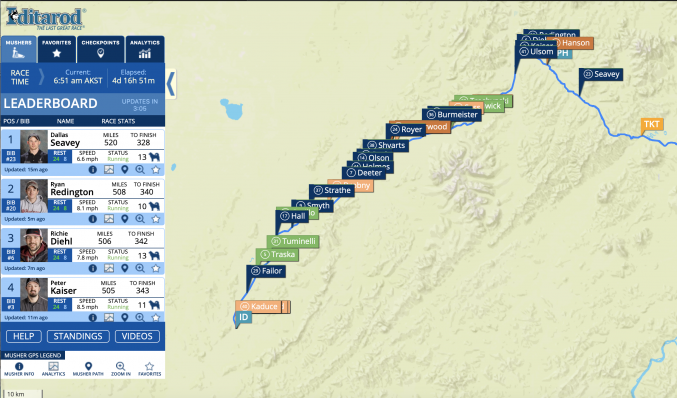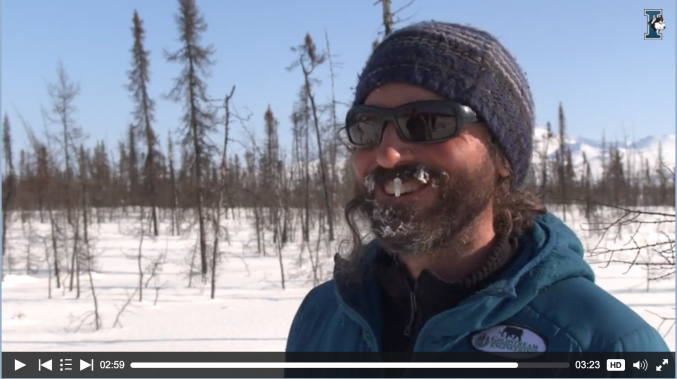This morning the GPS tracker was a sight to behold! A never before seen picture of Iditarod! With the exception of Dallas Seavey, every team was either in Ophir, in Iditarod or in between. It was two-way traffic on what mushers say is not always a two-lane trail. Seavey, the first musher to reach Ophir coming from Iditarod seemed to manage the nuances of the unique two-way traffic pretty well. Tracker analytics shows some stop and go action in Seavey’s run but that would be typical of routine snacking.
Being the first musher to reach Ophir southbound as its officially called or inbound as my brain processes it, Seavey won The Lakefront Anchorage First Musher to the Yukon Award. The award consists of a five-course meal prepared by The Lakefront executive chef which will be served to Seavey and guests in the spring. The “After Dinner Mint” will be $3,500 in one dollar bills along with a bottle of Dom Pérignon. Seavey owns four championships but this is the first time he has earned The Lakefront First to the Yukon Award.
The out and back trail offers the mushers a different mindset then the race to Nome. Tough spots would be conquered and then go in the review mirror not to be revisited again. Get through it and it’s done, then move on to the next challenge. But in this race you return to the same challenges and it can play with a musher’s mind and create anxiety. Musher’s who tried to create a mental database of rough spots on the out bound trail pretty much gave up doing so, deciding instead to take each challenge as they return to it.
Mushers particularly mentioned ICE to be a concern, be it the glacier between Nicolai and Rohn or the frozen river outside of Rohn on the gorge side of the trail. There are many positives to the cold weather including the possibility that the overflow between McGrath and Nikolai might be frozen for the return trip. That ice would be good ice!
For Friday morning, the action is densely concentrated between Ophir, Iditarod and Ophir. The effects of the dense traffic along with temperatures plummeting below zero to number the thermometer doesn’t show may well create a firm fast trail between the two checkpoints. On the other hand, the caution needed for passing may slow the teams, but maybe not. Seavey’s run time from Ophir to Iditarod was 13 hours and 12 minutes at 6.06 mph. He covered the Iditarod to Ophir run in 13 hours and 24 minutes at 5.97 mph. He rested on both of those runs.
Teams are showing some interesting run/rest strategy. Several have rested twenty miles outside of Iditarod. Seems likely they’ll pick up supplies at Iditarod and make the 180 toward home. The question is how far will they go back toward Ophir before setting the hook for another rest.
Cody Strathe and his wife and kennel partner Paige Drobny are both on the trail. Between them they have a number of Iditarod and Yukon Quest finishes. In 2016, the Squid Acres partners did double duty in Iditarod and also Yukon Quest. They claimed the honor of being the first husband/wife mushers to complete both races in the same year. Strathe praised his leader Sable, a dog who’s been leading for Squid Acres since the age of two. This is her 15th 1,000 miles race and many years she’s gone back to back with Yukon Quest and Iditarod. She’s finished all of her 1,000-mile races except the few they’ve scratched from. Sable sounds like a durable legend!
Stay tuned as the day wears on. Dallas is leading but there are teams within striking distance. How will teams use the “floating” interior rest? The trail is hard and fast. Tricky, treacherous, technical trail lies beyond McGrath. Have you done any calculations as to when the Champion will be crowned back at Deshka? Neither have I.



































